A Comprehensive Guide to Caring for Crested Geckos
January 19, 2023
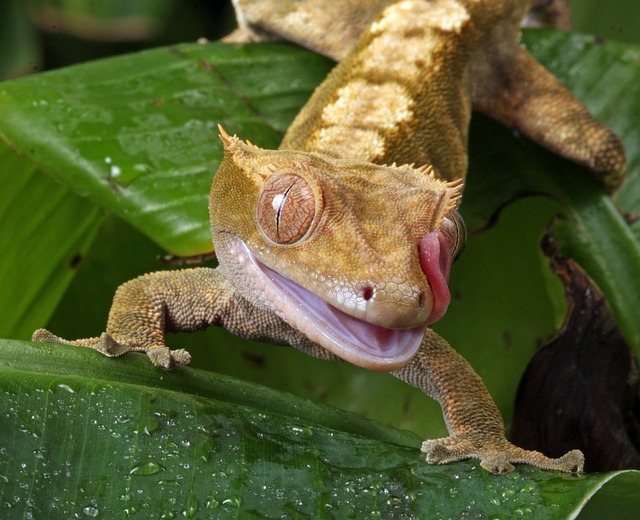
Table of Contents
- Handling Your Crested Gecko
- Crested Gecko Enclosure
- Crested Gecko Lighting and Humidity
- Crested Gecko Substrate
- Feeding Crested Geckos
- Crested Gecko Tail Loss
The Complete Guide to Crested Gecko Care
In nature, crested geckos can be found hanging out in the trees in New Caledonia. These geckos make excellent pets due to their low maintenance and manageable size. Crested geckos can grow to be 8 inches from their snout to the tip of their tails. When handled from a young age, they become calm pets that will happily hang out in your hands. Crested geckos come in a variety of morphs (colors and patterns) and can truly be stunning creatures. Before purchasing one of these lizards, you should take into consideration that they can live to be 15 - 20 years old.
Handling Your Crested Gecko
When you first bring home your crested gecko, you should put it directly into its enclosure and avoid handling it for a week. This will give your gecko time to settle in and get comfortable with its new surroundings without being stressed by handling. After a week, you can begin handling your crested gecko so that it gets used to you. When handling your gecko, try to stay close to the ground. They are jumpers, and a fall from a large height can be harmful to them. It is best to sit on the ground and just move and over hand as your gecko walks. Crested geckos rarely bite and are overall docile creatures. If your gecko does bite you, it's best to let it let go of you on its own. Their bites don’t hurt very much, and trying to pull them off can damage their teeth.
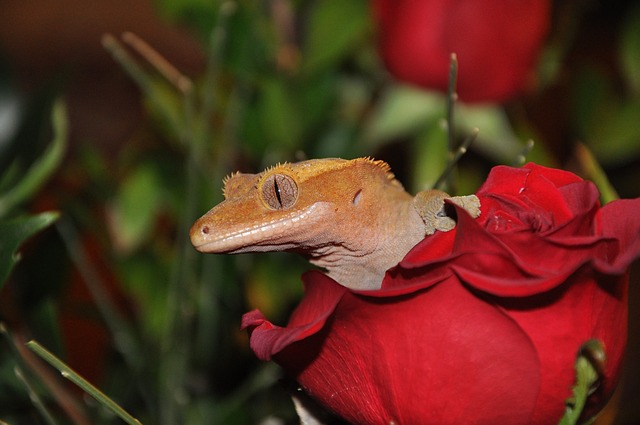
If you already own other reptiles, it is best to quarantine your gecko in another room away from them for at least a month. Reptiles can spread disease, parasites, and mites between each other. I have a detailed article on quarantining reptiles here. If this is your first reptile, you don’t have to worry about spreading anything, however, I still recommend monitoring them closely for the first month to ensure they are healthy. Using paper towels as substrate can be beneficial for this to check that their droppings are healthy.
Crested Gecko Enclosure
Crested geckos are an arboreal species, and therefore they need a tall enclosure. An adult crested gecko will need an enclosure that is at least 12 x 12 x 24 inches. Baby crested geckos can be started out in smaller enclosures and moved up, though it doesn't hurt to put them into their adult enclosures right away if it is properly cluttered. Another enclosure option is to take a 20 gallon fish tank and convert it so that it is standing up vertically. Conversion doors are sold to specifically fit these tanks, and can sometimes be a cheaper option than buying a premade tall tank. When in doubt, always check facebook marketplace for used tanks to find a good bargain.
How to Clean a Crested Gecko Enclosure
Crested geckos tend to be messy eaters, smearing their food on the glass as they eat. It's cute to watch, but it does mean their enclosure should be cleaned frequently. Spot clean their enclosure daily, and do a full deep cleaning once a month. During this deep cleaning, you will want to remove their substrate and hand wash all their accessories with dawn dish soap. Be sure to rinse the enclosure and accessories well, allowing them to fully dry, before setting the enclosure back up.
Crested Gecko Accessories
Crested geckos need to be supplied with hiding places to feel secure in their environment. Cardboard paper towel inserts are a cheap, yet effective way to supply your gecko with hides and climbing opportunities. Driftwood and cork logs are also excellent, more aesthetically pleasing climbing options. There are also hanging hides made specifically for crested geckos. I have a coconut hide in one of my enclosures that I got on Amazon. It's both cute and functional. Both live and fake plants can add a lot visually to your tank, and provide areas for your crested gecko to hide. If you decide to go with a fully naturalistic terrarium, I have a guide to building bioactive enclosures here. Your crested gecko should be supplied with a fresh dish of shallow water daily. Some geckos will prefer to drink the dewdrops off the glass instead, but regardless they should be provided with a dish of water.
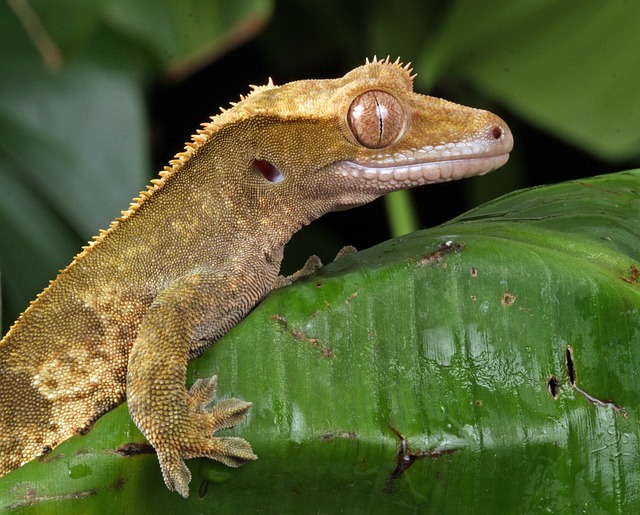
Crested Gecko Lighting and Humidity
Unlike many lizards, UVB lighting isn't required for crested geckos. That being said, there are studies that show that UVB can still be beneficial to their wellbeing. UVB helps to boost immune systems, encourages crested geckos to be more active, and can increase brightness in their coloration. I recommend purchasing a UVB light, and leaving it on for 12 hours a day. Your geckos tank should also be located in a room with natural light coming in from a window. The enclosure should not be placed in front of the window though, as the sun shining directly through the glass can cause lethal temperatures. Crested geckos typically do not need a heat source unless your house stays cold. Their ideal temperature range is between 72 °F - 80 °F. Make sure their enclosure temperature does not exceed 85 °F, as temperatures this high can be deadly to them.
The humidity in a crested geckos enclosure should be maintained between 50% - 70% to ensure they stay healthy and have full, proper sheds. Crested geckos eat their sheds, so don’t be alarmed if you don’t see them shed. This humidity range can be achieved through regular misting with a spray bottle. You will need to purchase a hygrometer for your crested gecko’s enclosure. This will give you an accurate reading of both the temperature and humidity in the tank. These can be a bit pricey in pet stores, but amazon sells them at an affordable price. If you are struggling to maintain humidity in your crested geckos enclosure, you could add some moss at the bottom. Moss helps to hold humidity when damp, plus it is an excellent enrichment opportunity since it provides your gecko with new and exciting smells.
Crested Gecko Substrate
Being an arboreal species that does not spend too much time on the ground, crested geckos are not too picky about substrate. Paper towels are a cheap, easy to clean substrate that works well. If you are wanting a more naturalistic look, both coconut husk and coconut fiber are excellent choices, plus they will help to hold in humidity. Stay away from pine or cedar as these substrates are known to be toxic to reptiles and can cause respiratory infections.
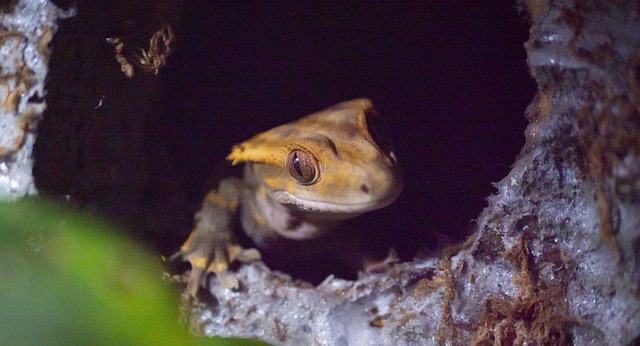
Feeding Crested Geckos
Crested geckos are omnivores that feed on both fruits and insects. Both Repashy and Pangea sell premade powdered foods (that you mix with water) that have a balanced mix of fruits and insects to meet your geckos needs. I personally use Pangea with my crested geckos and have excellent results, but I have heard good reviews on Repashy as well. Both brands have a variety of flavors available, so you're bound to find a flavor that your gecko likes. Stay away from baby foods. When crested geckos were first discovered many keepers fed them baby food, but over the years we have learned that it does not offer a balanced diet. Baby crested geckos should be offered new food daily. Adults can be offered new food every other day. You can buy feeding ledges to hold cups of their food up against the glass. They make suction cup style ones and magnetic ones. I use both without issues, but I do feel like the magnetic ones are stronger and better for holding full grown females. You can supplement your crested geckos powder diet by offering crickets or dubia roaches a couple times a week too. When offering insects, you should lightly dust them with a calcium supplement.
Crested Gecko Tail Loss
Like many geckos, crested geckos have the ability to drop their tails when startled. In the wild, this skill helps them to evade predators. Unlike many other geckos, crested geckos unfortunately do not grow back their tails. Thankfully, a dropped tail is not a cause for concern and is purely cosmetic. If your crested gecko drops their tail, move them to a temporary enclosure with paper towels for substrate (if you aren't using paper towels already) to prevent loose substrate from sticking to their wound. Do not be alarmed if the detached tail wiggles or moves for a few seconds. This is also completely normal, and would be a distraction to predators in the wild.

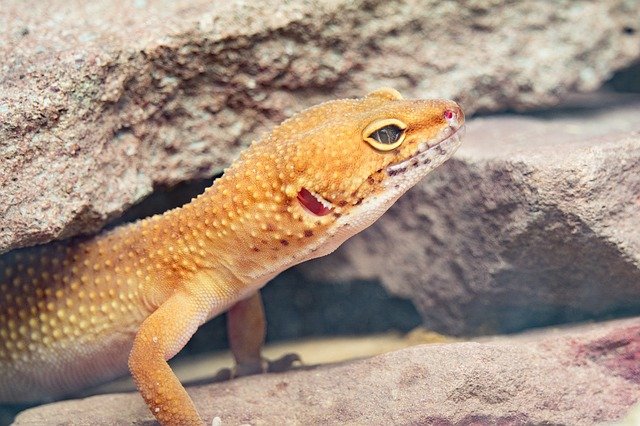




Sending...